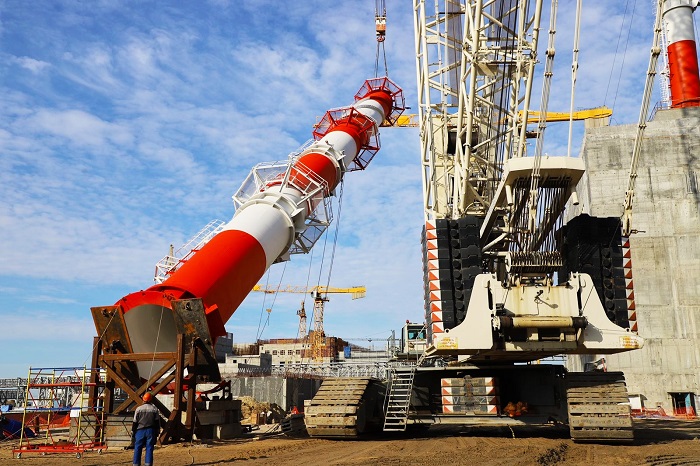Specialists of Kursk Branch Office of Trest RosSEM LLC (subsidiary construction organization of ROSATOM Engineering Division) completed the installation of ventilation stack of the auxiliary reactor building of Kursk NPP-2 Unit 2.

The installation of the complex metal structure was carried out in three main stages. After the stack elements had been manufactured in the workshop, they were pre-assembled on the ground in one mounting unit 54.5 m long at a specialized site close to the building. After that, the assembled unit was put in design position at elevation +35.000 m, with the help of a caterpillar crane with a loading capacity of 1200 tons.
The manufacture, pre-assembly and installation of the ventilation stack at Unit 2 took 35 days, which is 27 days less than the similar works at Unit 1. Such results were achieved due to optimization of the process operations and elimination of non-production losses.
The ventilation stack is part of the process ventilation system of the reactor buildings and the special building. It is intended for removal of excess heat and moisture and maintenance of the necessary conditions for operation of the equipment and the maintenance personnel during repair and refueling or the reactor shutdown. After passing through the filtration units with a high degree of purity, the cleaned air is fed to the stack, and accordingly it does not pollute the atmosphere.
“The ventilation stack is one of the highest structures in the power unit start-up complex, exceeded only by 179-m evaporation cooling towers”, said Oleg Shperle, Vice President of ASE JSC, Director of Kursk NPP Construction Project. “The design characteristics of the ventilation stack are intended to withstand strong wind loads and seismic impact up to six points”.
For reference:
Units 1 and 2 of Kursk NPP-2, Generation III+ are pilot units built under VVER-TOI design (standard optimized digital water-water power reactor). This is a new design created by Atomenergoproekt JSC based on technical solutions of VVER-1200. The Units have improved technical and economic parameters. Compared to the other III+ generation power units, the VVER-TOI project is characterized by a significant reduction of construction costs, timelines and operating costs. The power of each unit grew by 25%, reaching 1255MW compared to the units of the currently operating Kursk NPP.
The ROSATOM Engineering Division unites the leading companies of the nuclear industry, namely: Atomstroyexport JSC (Moscow, Nizhny Novgorod, branches in Russia and abroad), Joint Design Institute – Atomenergoproekt JSC (Moscow, Nizhny Novgorod, St. Petersburg branches – design institutes, branches in Russia and abroad, R&D branches) and subsidiary construction organizations. The Engineering Division ranks first in the world by the order portfolio and the number of NPPs constructed simultaneously across the world. About 80% of the Division’s revenues originate from foreign projects. The Engineering Division implements construction projects for high-power NPPs in Russia and across the world, renders a full range of EPC, EP, EPC(M) services including project management and design activities, and develops Multi-D technologies for the management of complex engineering facilities. The Division relies on the achievements of the Russian nuclear industry and innovative state-of-the-art technologies.